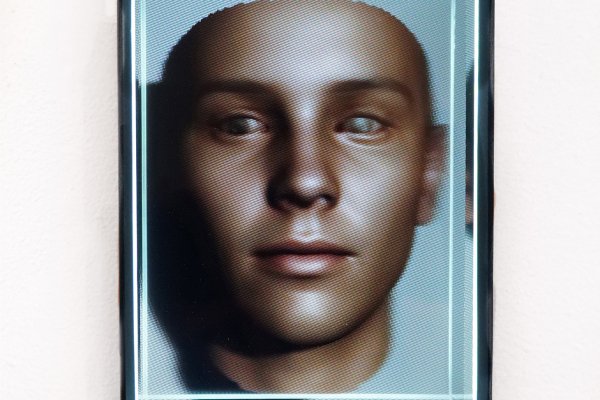Watson's Ghost

The artist and researcher Heather Dewey-Hagborg locates herself between the art genres of Bio Art, AI Art and Sound Art and develops objects, videos and installations as transdisciplinary works that unfold at the interfaces of art and science. This "biopolitical art practice" focuses on an art that itself becomes research - art as a scientific method. In audiovisual installations and by means of generative computer technologies, various systems are disassembled into their smallest building blocks and rearranged, whether this is the complexity of the system of language, as in Netlingua (2003), or when a virus is depicted, as in Lovesick: The Transfection (2019). The situations the artist creates for the audience question perceptions of people, technology and the environment, embodying concepts of a world viewed through the "lens of information." Thus, in some works, Dewey-Hagborg creates the image of a microcosm that reveals itself only to the senses of the visitor, exploring intersections between art and life, naturalness and artificiality through an artistic-research method. As the artist writes in a statement: Through creative practice in the medium of life itself, my work aims to bring the viewer into a deep and complex relationship with their own biology and a visceral understanding of the social implications of new technologies.
This approach of interweaving art and science is already evident in modernism, for example in works of the Russian avant-garde. In his first abstract works, for example, Wassily Kandinsky examined not only the effect of colours and forms, but above all their perceptive qualities in the sense of perceptive-psychological experiments. In the process, the human perceptual apparatus became an object of artistic investigation. Experiments in the perception of optical stimuli led the artists to an examination of the macrocosm of the human body down to the microcosm of the time - through the invention of the X-ray apparatus, which for the first time completely illuminated the human body. The lines of connection between art and science can be wonderfully traced retrospectively, as the art historian Sabine Flach has already shown in her habilitation thesis "Sensing Senses. The Knowledge Arts of the Avant-Garde. Artistic Theory and Practice between Perception Science, Art and Media". These approaches are still clearly evident in many works of Bio Art, including Dewey-Hagborg, who appropriates the latest technological and molecular biological methods, procedures and findings as artistic strategies. In doing so, she takes the phenomenological experiment in perception even further by going beyond the human senses to reveal, dissect and stage the smallest molecular structures of the human being, the world "as what we perceive".
The esc medien kunst labor presents Watson's Ghost, a work developed in 2021. It consists of two 3D-printed objects and a holographic video shown via "Looking Glass" technology. Looking Glass" is an open-source project in which a 3D user interface was developed according to a stereoscopic projection.
In terms of content, the installation - consisting of video and objects - deals with a question that is always very essential for the artist: "How much can I learn about a stranger from a hair?" In the installation Stranger Visions from 2012 to 2013, Dewey-Hagborg already investigated how DNA samples collected in public space, such as from a cigarette butt, can be represented by generating possible portraits of people as 3D prints from the DNA strands obtained.
Watson's Ghost thematisiert DNA indes vielmehr noch als Inhalt des Kunstwerks, indem dieses Mal der „Entdecker“ des Doppelhelixmodells, der Molekularstruktur der DNA, James Dewey Watson, in den Mittelpunkt der künstlerischen Auseinandersetzung rückt. Watson löste durch provokative Äußerungen immer wieder Kontroversen und heftige Kritik an seinen gesellschaftspolitischen Vorstellungen aus. Bereits 1997 sprach er sich in einem Interview mit der italienischen Zeitung „Corriere della Sera“ für das Recht der Frau zur Abtreibung aus, wenn aus einer genetischen Analyse des Embryos hervorgehe, dass das ungeborene Kind homosexuell veranlagt sei. Rassistische Annahmen, die in der Eugenik begründet wurden, wie dass menschliche Eigenschaften wie Libido oder Intelligenz rein genetisch begründet seien, wurden von Watson immer wieder öffentlich zum Ausdruck gebracht.
Dem Titel der Installation folgend, befasst sich die Künstlerin mit dem „Geist“ des Molekularbiologen, was seine Tätigkeiten als Wissenschaftler ebenso umfasst, wie seine als äußerst problematisch zu betrachtenden Aussagen über die Bedeutung der DNA für den Menschen. Dabei beweist die Künstlerin über das Kunstwerk eine Antithese zu Watson, die sie an seiner Person exemplifiziert und über die Installation zum Ausdruck bringt. In einer Art „Triptychon“ computergenerierter, genetischer Porträts von Watson wird eine Vielzahl der möglichen Interpretationen des Aussehens von Watson dargestellt, die allein auf seiner DNA basieren und damit die tatsächliche Komplexität des Lebens verdeutlichen. In dieser Verbildlichung der DNA, die eine künstlerische Rekonstruktion bestimmter DNA-Stränge darstellt, wird das Kunstwerk zur ästhetisch wahrnehmbaren Antithese einer wissenschaftlichen Annahme. [MA Elisabeth Passath]
